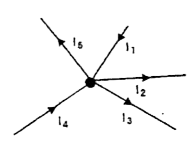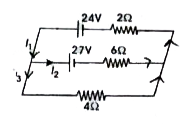State and explain Kirchhoff's laws.Solution in Punjabi
Kirchhoff.s First law: It states that algebraic sum of currents meeting at a point in an electrical circuit is zero. It is also called junction rule. Explanation: Consider a point O in an electrical circuit at which currents I1,I2,I3,I4andI5 are flowing through the five conductors in the directions as shown in Fig. below. Let us adopt the following convention: The current flowing in a conductor towards the point O is taken as positive and the current flowing away from the point O is taken as negative. Likewise, currents I1andI4 flowing towards the point O are positive, while the currents I2,I3andI5 are negative. Therefore, according to Kirchhoff.s First Law,
I1+(−I2)+(−I3)+I4+(−I5)=0
or I1−I2−I3+I4−I5=0

Kirchhoff.s second law: It states that in any closed part of an electrical circuit, the algebraic sum of the e.m.f.s is equal to the algebraic sum of the products of the resistances and currents flowing through them. It is also called loop rule.
Sign Convention :
1. If the path taken to traverse the resistance is along the direction of current, then the product of current and resistance is taken as negative i.e., -IR.
2. If the path taken to traverse the resistance is against the direction of current, then product of current and resistance is taken as positive i.e., + IR

3. If the electric current flows through the cell from its negative to positive terminal then emf of cell is taken as positive (+E).
4. If the electric current flows through the cell from its positive to negative terminal then emf of the cell is taken as negative (-E)

To understand these rules we consider the following electrical circuit. Applying loop law to the upper and lower loops anticlockwise,
−2I1−6I2+24−27=0
or −2I1−6I2=3....(i)
and −4I3+6I2=−27
or −4(I1−I2)+6I2=−27(∵I1=I2+I3orI3=I1−I2)
or −4I1+4I2+6I2=−27
or −4I1+10I2=−27 ...(ii)
Solving (i) and (ii), we get I1=3A,I2=−1.5A
∴I3=I1−I2=3−(−1.5)
= 4.5A

Topper's Solved these Questions
- BOOK - BETTER CHOICE PUBLICATIONCHAPTER - ELECTRICAL MEASUREMENTSEXERCISE - Long Answer Type Questions7videos
ELECTRICAL MEASUREMENTS
- BOOK - BETTER CHOICE PUBLICATIONCHAPTER - ELECTRICAL MEASUREMENTSEXERCISE - Numericals Problems9videos
ELECTRICAL MEASUREMENTS
- BOOK - BETTER CHOICE PUBLICATIONCHAPTER - ELECTRICAL MEASUREMENTSEXERCISE - Most Expected Questions7videos
ELECTRICAL MEASUREMENTS
- BOOK - BETTER CHOICE PUBLICATIONCHAPTER - ELECTRICAL DEVICESEXERCISE - (MOST EXPECTED QUESTIONS 2 MARK)2videos
ELECTRICAL DEVICES
- BOOK - BETTER CHOICE PUBLICATIONCHAPTER - ELECTROMAGNETIC INDUCTIONEXERCISE - NUMERICAL PROBLEMS26videos
ELECTROMAGNETIC INDUCTION
Similar Questions
State and explain Kirchhoff's laws.
04:41View SolutionA cell of e.m.f. 1 V gives a balance point at 40 cm length of a potentioeter wire. For another cell, the balance point shifts to 60 cm. Find the e.m.f. of the second cell.
View SolutionWhy is a slide wire bridge also called a metre bridge?
View SolutionWhy the core of a transformer made of a magnetic material of high permeability?
01:36View SolutionA magnetic field of 2×10−2T acts at right angles to a coil of area 100cm2 with 50 turns. The average e.m.f. induced in the coil is 0.1 V, When it is removed form the field in the time t. The value of t is
03:02View SolutionState Kirchhoff's laws in electricity.
01:33View SolutionState Kirchhoff's Junction Law.
04:06View SolutionState Kirchhoff's Loop law.
10:01View SolutionState Kirchhoff's law of radiations.
01:09View SolutionState the two Kirchhoff's laws.
04:06View SolutionState and explain the Kirchhoff's law of heat radiation.
01:44View SolutionState Kirchhoff's law of radiation.
01:44View SolutionState and explain Kirchhoff's laws. Discuss some of it's important applications.
03:41View SolutionState the uses of Kirchhoff's Laws.
03:19View SolutionState Kirchhoff's Laws.
04:50View SolutionState and explain the sign conventions for Kirchhoff's first law.
02:59View Solution

